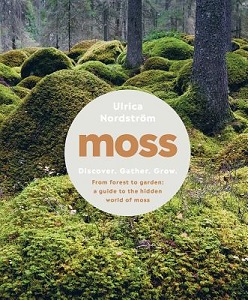
When was the last time you stopped during a walk and looked closely at the tufts of tiny green leaves growing on the sidewalk or on the trunk of a tree or on a humble rock? Have you found yourself staring at a clump of moss in your garden wishing it were gone? If you wish to know more about mosses–and perhaps gain a bit of appreciation for them–this book is for you.
Moss by Ulrica Nordström is a book dedicated to these tiny, ancient plants that first appeared on this planet over 350 million years ago. Coming after green algae and before the vascular plants, mosses are often quite literally looked down upon as a nuisance or as simply less desirable than the more charismatic vascular plants that dominate our collective imagination.
This book is a love letter to mosses. Nordström’s love of these “comforting” plants is clear with page after page giving careful attention and consideration to these oft-overlooked plants that blanket much of our world. promises, “once you have entered the exciting world of moss, you will want to see more of it.”
Moss includes information for those interested in learning to identify mosses, including useful tools to bring to the field, along with photographs, illustrations, and key characteristics of some of the most common species of moss. A large portion of the book is devoted to moss gardens around the world–including
Bloedel Reserve on Bainbridge Island–and care-filled spotlights of some of the gardeners who are responsible for those gardens and who also clearly fell in love with mosses. It rounds out with projects and ideas for both outdoor and indoor uses for mosses, for those interested in bringing mosses into their own lives.
This has quickly become one of my favorite books. But, I must confess that I’m biased. Mosses are my favorite plants and have been since I was a small child wandering the forests where I grew up. I think mosses have a kind of charisma of their own, the unassuming kind that invites people to pay closer attention to what makes them special. Mosses teach a kind of meditation of presence if we stop moving long enough to pay attention. After reading Nordström’s book, I can’t help but think she’ll be successful in opening up this “hidden world” to many readers.
Reviewed by Nick Williams in the Leaflet, Volume 10, Issue 4 – April 2023
I was in the backyard tidying up after my dog when I noticed a tiny orange mushroom growing out of the moss in the lawn. It is a fragile thing, about an inch long. The cap has a slightly darker indentation on top. Even the stem is orange, and the gills look like the fan-vaulted ceiling of a miniature cathedral and extend a short distance down the stem. I am curious to know what it is.
I confirmed with local mushroom experts that this is Rickenella fibula. It is fairly common in the Pacific Northwest, but seldom noticed, so good spotting! The technical description of gills that extend down the stem would be “decurrent, slightly traveling down the stipe.” Here is general information about this mushroom from Michael Kuo’s Mushroom Expert site. He mentions that it may have a mutualistic relationship with moss, and that is discussed further on the Forest Floor Narrative blog:
“Most species that occur with moss are saprobes that share similar niche requirements with the moss. That is, many of these organisms can only exist in a certain range of temperature, moisture, pH, and nutrient content of the substrate. Much of the time, they don’t directly interact. Moss loving fungi break down dead plant material that may leach and be absorbed into the plant, but these interactions are not considered mycorrhizal. Recent studies indicate that Rickenella fibula doesn’t just coexist with the moss it is found growing with. There is actually a direct interaction going on here.”
 When was the last time you stopped during a walk and looked closely at the tufts of tiny green leaves growing on the sidewalk or on the trunk of a tree or on a humble rock? Have you found yourself staring at a clump of moss in your garden wishing it were gone? If you wish to know more about mosses–and perhaps gain a bit of appreciation for them–this book is for you.
When was the last time you stopped during a walk and looked closely at the tufts of tiny green leaves growing on the sidewalk or on the trunk of a tree or on a humble rock? Have you found yourself staring at a clump of moss in your garden wishing it were gone? If you wish to know more about mosses–and perhaps gain a bit of appreciation for them–this book is for you. When was the last time you stopped during a walk and looked closely at the tufts of tiny green leaves growing on the sidewalk or on the trunk of a tree or on a humble rock? Have you found yourself staring at a clump of moss in your garden wishing it were gone? If you wish to know more about mosses–and perhaps gain a bit of appreciation for them–this book is for you.
When was the last time you stopped during a walk and looked closely at the tufts of tiny green leaves growing on the sidewalk or on the trunk of a tree or on a humble rock? Have you found yourself staring at a clump of moss in your garden wishing it were gone? If you wish to know more about mosses–and perhaps gain a bit of appreciation for them–this book is for you.